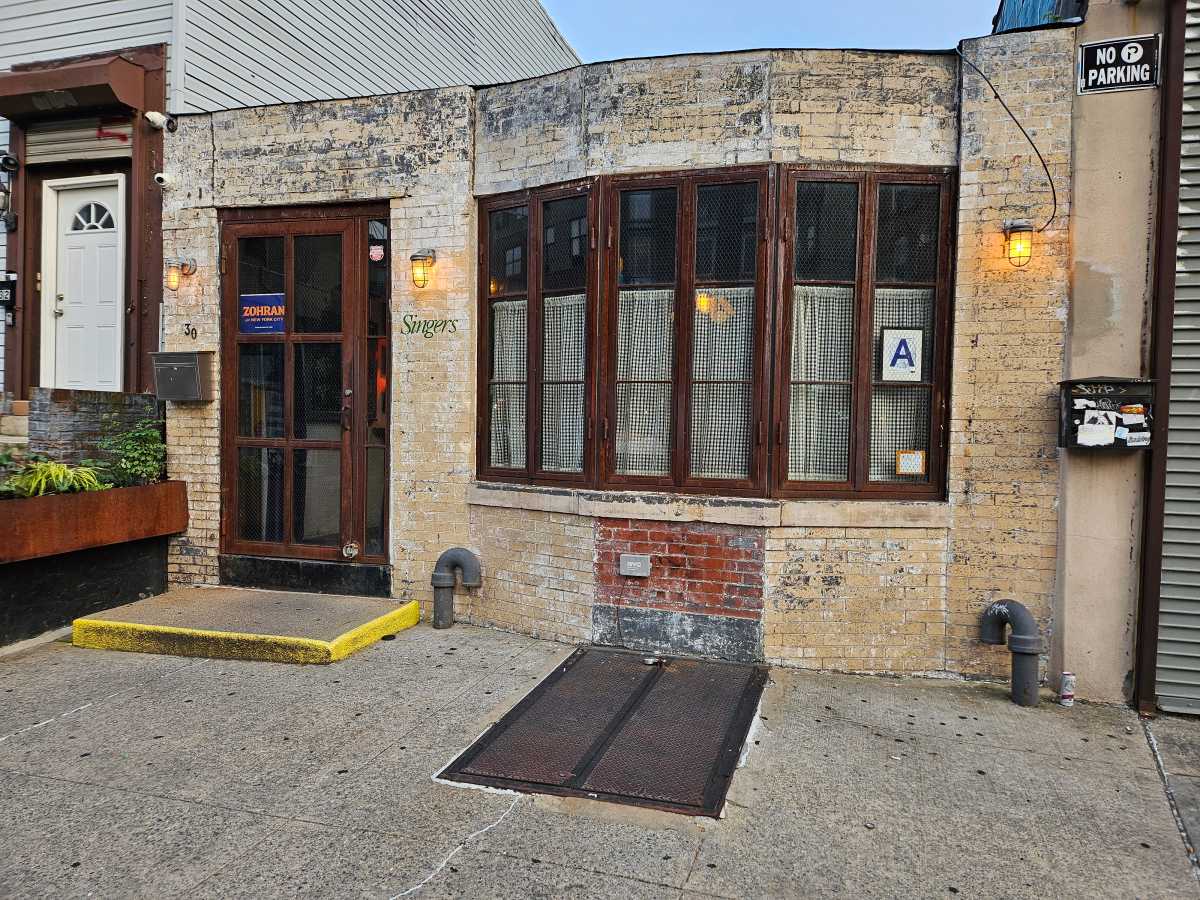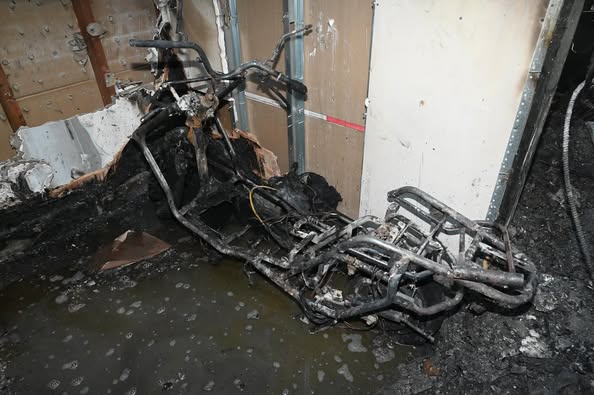By Lincoln Anderson
Developer Harry Macklowe will forever be known for ordering the so-called “midnight demolition” in 1985 of four S.R.O. buildings on W. 44th St. The infamous nighttime wrecking, done without a permit, symbolized a period when developers were harassing low-income tenants out of single-room-occupancy buildings, particularly in Manhattan.
Now, Noho co-op residents and businesses in one of the earliest remaining cast-iron buildings in New York City fear Macklowe is about to cause another sudden demolition — namely, of their building.
Last Wednesday, a long vertical crack opened on the southeast corner of 620 Broadway, next to which Macklowe Properties Inc. is constructing a six-story office-and-retail building on the site of a former carwash.
According to Jennifer Givner, a Department of Buildings spokesperson, inspectors determined at the scene that there is “no immediate danger” as a result of the accident, and that “no action [is] necessary,” based on the fact that the construction crew is now working to stabilize the building.
Built in 1859, the damaged building, known as the “Little Cary Building,” is in the Noho Historic District. Its name derives from the fact that it is narrower, though taller, than the better-known Cary Building at 105 Chambers St., which was cast with the same parts and at the same foundry.
Despite D.O.B.’s reassurances, however, residents don’t feel particularly comforted, especially given what occurred shortly after the project started in October: The building started sinking when Macklowe’s workers dug too deep. As a result, floors now slope noticeably downwards to the south, the walls in the lofts’ interiors are veined with cracks and doors no longer close in doorframes thrown out of alignment.
After the first accident, a stop-work order was enforced from Oct. 30 to Dec. 9. In December, the co-op owners filed a $20 million lawsuit against the developer, contending each floor will need at least $700,000 in repairs.
“They created a vacuum under our foundation and all this sand started rushing out like a river,” said Nancy Ney, a freelance photographer who owns a 2,200-sq.-ft. loft on the building’s second floor, recalling the October construction accident. “They tried to fix it by pumping in grout, but it was the wrong kind of grout and it was displacing the sand.”
In last week’s accident, Ney, the co-op board’s vice president, said a large backhoe with a jackhammer-like attachment was pounding away at the former carwash’s deck to remove it, when the exterior crack occurred.
D.O.B.’s Givner confirmed the department received complaints March 16, 19 and 22 from 620 Broadway saying that “heavy machinery was causing the building to shake and vibrate.” Two days after the last complaint, the exterior crack occurred.
Construction was halted last week while workers braced the cracked wall.
Like most of the tenants in the building’s 11 units, Ney lives and works in her loft. Noho is zoned for manufacturing, and only artists in residence are allowed to live in the district.
“We were worried the Department of Buildings would tell us we had to vacate the building,” said Ney. “I have all my work in here. This is our home. It’s the most basic thing.”
Ney showed a visitor her loft last Friday. The hardwood floor was noticeably sloped, there were thin cracks wherever walls joined, the bathtub was pulling away from the wall and tiles, doorframes were out of kilter. In short, it looked as if the loft had been taken by a giant hand and slightly twisted.
As Ney’s Jack Russell terrier barked menacingly, Macklowe’s workers traipsed in and out to work on an emergency brace in a 12-ft. hole cut through the ceiling in the southeast corner of her apartment near the exterior crack.
However, Richard Farewell, Macklowe’s project foreman at the site, attributed the problems mostly to preexisting conditions.
“It’s not something we created, it’s something we inherited,” Farewell said. “When they built the building back in 1850, they didn’t know it would stand 150 years.”
Farewell said they excavated too deep because building records showed the foundations being 6 ft. lower than in reality. Also, that the building is on sand adds to the instability, he said. Vibrations from the N and R subways running beneath the building, and the Lexington line running down Broadway could also be destabilizing the building, he added.
Conversely, Farewell said the vibration from the “330L” jackhammer-bulldozer was merely the equivalent of “kicking a car door.”
But Ney and the co-op’s attorney, Jack Lester, say the construction has been reckless. Ney said a structural engineer the co-op retained after the problems began told her, that when the Scholastic building was constructed nearby, the developers there, knowing Noho’s old buildings are fragile, “used teaspoons to take out the foundation” on the site.
Even if the Little Cary survives the construction, its artists in residence will likely have to relocate while their apartments are being totally rebuilt, causing loss of income. When they return, their southern exposures will be gone; all 80 lot-line windows, according to Ney, will be blocked by the new building, which will be “two inches away” from their windows.
Between the damages and the loss of light, “The apartments have been devalued incredibly,” she said. “We can’t sell them now. We can’t get out.”
Attorney Lester blasted Buildings for “laxity of enforcement” for not doing more to protect the tenants and the building after the initial October accident.
“D.O.B. has not done their job here,” he said. On the other hand, Lester said State Supreme Court Judge Richard Braun, who issued the initial stop-work order, has been concerned and active.
The Noho Neighborhood Association has contacted Councilmember Alan Gerson the Greenwich Village Society for Historic Preservation and the Historic Districts Council to turn up the heat on the developer and D.O.B.
“This is an Annie Leibovitz situation in the making,” warned Zella Jones, the association’s president, referring to the three crippled historic townhouses at Greenwich and W. 11th Sts., damaged a year and a half ago when Leibovitz’s workers undermined a party wall.
Steve Solomon, a Macklowe spokesperson, said it’s not uncommon for construction projects to have some impact on adjoining properties.
“Macklowe is a highly respected developer, and any problem caused by his construction he will attend to,” he said. “The engineers from both sides are working together to solve the problem.” Solomon said Macklowe’s son, William, is more in charge of the business nowadays.
Asked about the midnight demolition of 19 years ago, Solomon claimed Macklowe had been cleared of 90 percent of the charges involved, and accused the media of pumping it up into more of a story than it was.
Michael McKee, associate director of Tenants & Neighbors, a tenants’ advocacy group, said he remembers well the Macklowe midnight demolition.
“He should have gone to jail for it,” McKee said. He said it was the first he’d heard of the 620 Broadway situation, but commented, “If I were living in the building, I’d be very concerned about a 30-ft. crack on the building; and I’m surprised the Department of Buildings hasn’t put a stop-work order on the job.”
Farewell said the new building should be finished by June or July.
Unfortunately, for the residents of 620 Broadway, their ordeal probably won’t end anytime nearly as soon. Lester said the building’s top two floors may need to be taken down entirely and rebuilt. “This is a building under siege right now,” he said.
Villager photo by Elisabeth Robert






































